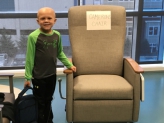Blockade of Mycn in neuroblastoma
1. Layman's Title for your Research Project:
Approaching neuroblastoma therapy by targeting the best characterized genetic abnormality associated with this disease, Mycn.
2. Research Objectives
What do you hope to achieve through your research and what will it mean to the world of childhood cancer if your project is successful?
Neuroblastoma is the third most common cancer of childhood. Average age of patients is 16m at diagnosis, and this tumor is rare over age 10. About half of patients present with high-risk disease, which means that they are likely to respond to initial therapy only to have tumors recur. These children are currently treated quite aggressively. Cures are rare in this group and the therapy itself may have significant side effects. Better cures are needed for these patients.
A substantial number of high-risk patients show extra copy of MYCN, a gene that drives neuroblastoma and is likely a critical contributor to the high-risk disease in these patients.
3. What is innovative about the approach you are taking?
Amplification of MYCN is a strong independent predictor of poor patient outcome. Mycn represents an attractive target for therapy, as it is serves as a genetic marker for subset of high-risk neuroblastoma and it is expressed at relatively low levels in normal tissues. The ability to inhibit Mycn in patients however, presents a formidable challenge. Many proteins active in cancer (kinases) act by adding a phosphate to a target, thereby altering the activity of the modified target. A second class of molecules active in cancer are transcription factors, proteins that bind DNA and turn on the expression of genes critical to the continued survival of cancer cells. Although many drugs have been developed that block kinase function, there is little precedent for development of orally available small molecules that selectively target transcription factors. Our proposal leverages the observation that the stability of Mycn, a transcription factor, is markedly impacted by phosphorylation, and that Mycn can be destabilized and degraded using small molecules that drive its phosphorylation. Since identifying this class of inhibitors, we have more fully characterized both the efficacy and toxicity of these drug-like molecules against neuroblastoma tumors in cell culture, and in animal models. We have previously generated and characterized a mouse model of neuroblastoma driven by MYCN, which shares many features with high-risk childhood neuroblastoma. In mice with neuroblastoma, daily treatment with a drug that broadly blocked Mycn (but also interfered with other cell functions was effective) but resulted in significant toxicity. In contrast, mice treated with a more selective inhibitor (PW-12) showed significant shrinkage of tumor, with no observable toxicity. These observations indicate that PW-12 can block Mycn at a dose much lower than that which causes general toxicity, suggest that a safe therapeutic index may be possible for similar drugs of this class. In this application, we will further test PW-12 to validate the approach of linking increased specificity to decreased toxicity within this class of compounds. Importantly, we have recently negotiated with Novartis to test a drug that targets Mycn in a manner similar to that achieved by PW-12, and that is already being used in clinical trials for adult cancer. We will determine whether this drug (BEZ-235) acts in a manner analogous to PW-12, generating preclinical data to determine whether this drug should be tested in children with neuroblastoma.
4. Explain in simple terms how you will conduct your research, for example, is it lab based, is it a clinical trial, are children directly involved?
This is lab based research. No children are involved, however succseful completion of these studies should pave the way to a clinical trial. The drugs we will use are in clinical trials in adults with cancer.
5. What is innovative about the approach you are taking?
We are working with a novel class of drugs which we helped to identify, and which Pharma has concurrently or subsequently developed.
- We showed that this class of drugs has activity against Mycn. This fact was not known or not widely known prior to our work
- We propose to use this class of drugs in a genetically engineered mouse model for neuroblastoma driven by MYCN. This is among the only, if not the only genetically engineered mouse models of neuroblastoma available to the scientific community. My lab developed this line of mice about 10 years ago and distribute these to any lab that requests them.
6. If there is collaboration, international or national, who is it with, and how will you work together?
We collaborate with Novartis, a pharmaceutical company that makes the drugs we use, with Kate Matthay, a clinician who works on neuroblastoma, and with chemists at UCSF who can generate other drug-like molecules that show improved activity against Mycn. The disavantage of the drug-like molecules is the length of time required to develop these into drugs.

